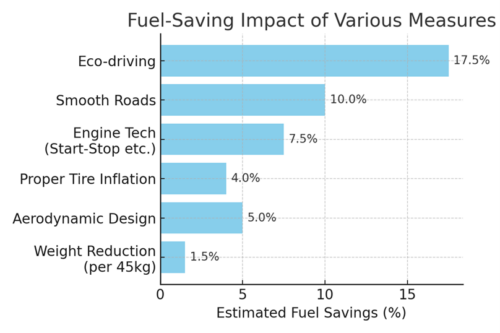
How Road Quality Impacts Fuel Consumption
Smooth roads are the second most impactful factor in improving fuel efficiency—just behind eco-driving. In this blog article, we explore how road surface quality significantly influences fuel consumption in vehicles. We’ll also look at other key factors that affect fuel efficiency and what can be done to reduce overall fuel use.
Fuel consumption in vehicles is affected by a mix of design, environmental, and behavioral factors. Understanding these can help drivers and policymakers make better decisions to reduce fuel use and emissions.
Major Factors Affecting Fuel Efficiency:
Following list explains different ways of reducing fuel consumption:
- Driving Behavior: Smooth acceleration, anticipatory braking, and steady speeds can lead to up to 25% fuel savings. Known as “eco-driving,” this is one of the most effective and cost-free methods to improve fuel economy.
- Road Quality: Often overlooked, road conditions—particularly surface smoothness—have a significant effect on fuel economy, offering 8 – 18% in savings.
- Engine and Transmission Technologies: Features like turbocharging, CVTs, and start-stop systems improve internal efficiency, offering 5–10% in savings.
- Aerodynamics: Streamlined vehicle shapes, covered underbodies, and smooth mirror designs help at highway speeds, saving 3–7%.
- Tire Pressure: Underinflated tires increase rolling resistance. Keeping them at optimal pressure can save 3–5% in fuel.
- Vehicle Load: Every additional 45 kg (~100 lb) of weight can increase fuel consumption by around 1–2%. Carrying only essential cargo and removing roof racks helps reduce drag and weight.
Following graph shows fuel savings from various measures:

How Road Quality Impacts Fuel Consumption:
Good road infrastructure doesn’t just reduce accidents—it also lowers fuel consumption significantly. Here’s why:
- Reduced Rolling Resistance: Smooth surfaces reduce friction between the tires and the road. On bumpy or potholed roads, more energy is required to overcome resistance.
- Less Acceleration/Braking: Drivers tend to maintain steadier speeds on smooth roads. On rough surfaces, they slow down or swerve frequently, causing inefficient fuel usage.
- Reduced Suspension Work: Rough roads force the vehicle’s suspension system to work harder, which indirectly saps engine power. The vertical up-and-down motion of the car body takes energy directly from the car’s engine.
- Better Aerodynamic Flow: Vehicles maintain higher, more constant speeds on well-maintained roads. This reduces aerodynamic drag, especially at highway speeds.
To put numbers on this, following graph shows fuel impact of road quality for a compact car. Going from 6 to 6.7 liter/100km is a 11% increase on consumption, happening on every single car driving on such road.
Conclusion
While personal driving habits and vehicle maintenance are crucial, improving road infrastructure can provide fuel savings across the entire vehicle fleet—commercial and private alike. Smooth roads are not just a matter of comfort or safety, but also an important lever in reducing national fuel use and greenhouse gas emissions. And maybe surprisingly, the impact is not small. It is the second most important factor as explained in this article.
At XenomatiX, we specialize in precise road quality analysis through advanced LiDAR technology in combination with other sensors — helping governments, engineers and road authorities make data-driven decisions that lead to safer, smoother, and more fuel-efficient roads.